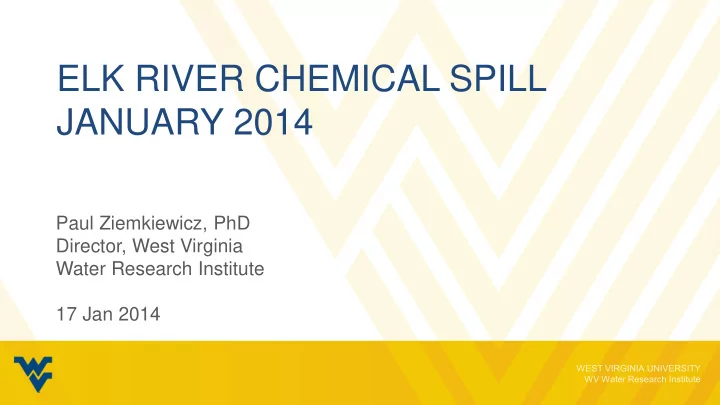

ELK RIVER CHEMICAL SPILL JANUARY 2014 Paul Ziemkiewicz, PhD Director, West Virginia Water Research Institute 17 Jan 2014
4-METHYLCYCLOHEXANE METHANOL CAS 34885-03-5 MCHM • Has a long name • No one can pronounce it • Keeps turning up in the press • I’m compelled to sympathize
4-METHYLCYCLOHEXANE METHANOL • Surfactant MCHM – Detergent-foaming agent-wetting agent – Binds to organic matter and water • Used in coal preparation • Low solubility in water • Described as an oil
4-Methylcyclohexanemethanol ( MCHM ), is an organic compound with the formula CH 3 C 6 H 10 CH 2 OH. Classified as an alcohol, it exists as two diastereomers with similar properties. It is a colourless oil with a faint mint-like, alcohol odor CITATION: PERKIN, WILLIAM HENRY; POPE, WILLIAM JACKSON (1908). "CIX.—EXPERIMENTS ON THE SYNTHESIS OF 1- METHYLCYCLO-HEXYLIDENE-4-ACETIC ACID. PART I". JOURNAL OF THE CHEMICAL SOCIETY, TRANSACTIONS 93 : 1075–85. DOI:10.1039/CT908930107
SURFACE TENSION ALLOWS HEAVY THINGS TO FLOAT ON WATER • A surfactant would cause them to sink/drown • If you’re trying to wash coal you don’t want bits of rock floating on the surface • MCHM also generates bubbles for the froth flotation process
SEPARATING COAL FROM ROCK- FROTH FLOTATION • MCHM helps make bubbles • Attaches to coal particles and makes them stick to the bubbles • Rock sink and go to the slurry impoundment
FREEDOM INDUSTRIES SITE • 1.6 miles upstream of West Virginia American Water intake • Leakage occurred at a 48,000 gallon tank • According to DEP about 7,500 gallons leaked
West Virginia American Water Freedom Industries 1.6 miles
MCHM TOXICITY-FROM MSDS • Not well characterized • Acute oral dose-825 to 2,000 mg/kg body weight, test results from rats • Irritant – Skin – Eyes – Lungs • Information based on concentrated MCHM
ESTIMATED DILUTION IN ELK AND KANAWHA RIVERS RIVER FLOW DURING MCHM DISCHARGE CAS 34885-03-5 4 methylcyclohexane methanol Q cfs gpm L/min 10-Jan-14 Elk River at Queen Shoals 2,370 1,064,130 4,027,732 10-Jan-14 Kanawha R. 15,700 7,049,300 26,681,601 MCHM density (grams/milliter) 0.884
ESTIMATED TIME TO DRAIN 7,500 GALLONS FROM A TANK WITH A 1” HOLE DRAINS @ ABOUT 8.22 GPM THIS IS VERY CRUDE SINCE THE RESISTANCE AT THE DRAINAGE END IS UNKNOWN ALSO, IF THE TANK IS BEING TOPPED OFF, YOU MIGHT NOT NOTICE THE LEAK Estimated time to drain tank* MCHM leaked minutes hours Tank: 48,000 gal gallons 7,500 912 15 grams 25,043,366 milligrams 25,043,366,400 milligrams/min 27,825,963 *assume 1 inch hole no head pressure or back pressure
ESTIMATED CONCENTRATIONS IN THE RIVERS (ASSUMES PERFECT MIXING) BUT, SINCE THE SPILL AND THE WATER INTAKE WERE ON THE SAME SIDE OF THE ELK RIVER, THE ACTUAL CONCENTRATION WOULD LIKELY BE HIGHER river concentration* 10-Jan-14 Elk River at Queen Shoals 6.9 mg/L 10-Jan-14 Kanawha R. 1.0 mg/L * assumes perfect mixing
40 CFR 112 OIL POLLUTION PREVENTION- APPLIES TO: • Petroleum oils and non-petroleum oils • Above ground tanks greater than 1,320 gal. • Includes production as well as storage and distribution facilities • Prevention of discharge of oil from non- transportation related facilities to navigable waters of the USA
4-Methylcyclohexanemethanol ( MCHM ), is an organic compound with the formula CH 3 C 6 H 10 CH 2 OH. Classified as an alcohol, it exists as two diastereomers with similar properties. It is a colourless oil with a faint mint-like alcohol odor CITATION: PERKIN, WILLIAM HENRY; POPE, WILLIAM JACKSON (1908). "CIX.—EXPERIMENTS ON THE SYNTHESIS OF 1- METHYLCYCLO-HEXYLIDENE-4-ACETIC ACID. PART I". JOURNAL OF THE CHEMICAL SOCIETY, TRANSACTIONS 93 : 1075–85. DOI:10.1039/CT908930107
40 CFR 112: SPILL PREVENTION, CONTROL AND COUNTERMEASURES PLAN (SPCC PLAN) ALL LARGE STORAGE TANKS SHOULD HAVE AN SPCC PLAN Spill Prevention, Control, and Countermeasure Plan; SPCC Plan, or Plan means the document required by § 112.3 that details the equipment, workforce, procedures, and steps to prevent, control, and provide adequate countermeasures to a discharge.
40 CFR 112: THE SPCC PLAN • Secondary Containment structure must be capable of containing oil and must be constructed so that any discharge from a primary containment system, such as a tank will not escape the containment system before cleanup occurs • Description of material in each tank and its capacity • Emergency response and notification • Inspections
SPCC PLAN: INSPECTIONS/RECORDS • Inspections, tests, and records. Conduct inspections and tests in accordance with written procedures that you or the certifying engineer develop for the facility. • You must keep these written procedures and a record of the inspections and tests, signed by the appropriate supervisor or inspector, with the SPCC Plan for a period of three years.
FOR MORE INFORMATION PLEASE CONTACT: Paul Ziemkiewicz, Director West Virginia Water Research Institute pziemkie@wvu.edu 304 293 6958
Recommend
More recommend